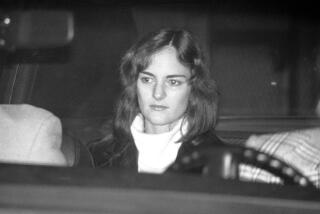Obituary Revives Rumor of Hearst Daughter : Hollywood: Gossips in the 1920s speculated that William Randolph Hearst and mistress Marion Davies had a child. Patricia Lake, long introduced as Davies’ niece, asks on death bed that record be set straight.
- Share via
What was for decades one of Hollywood’s juiciest rumors--the kind of scoop Walter Winchell and Hedda Hopper whispered about but never dared dish--unceremoniously surfaced this month in a newspaper death notice three paragraphs long, Page 14, Column 6.
Patricia Van Cleve Lake, “the only daughter of famed movie star Marion Davies and famed (publisher) William Randolph Hearst,” was dead.
Hollywood of the 1920s once buzzed with rumors that a child had been born of the scandalous affair so publicly conducted by Hearst and Davies--the eccentric newspaper monarch and his actress mistress. But the little blond girl who lived in the margins of the publishing dynasty was always introduced as “the niece of Miss Marion Davies.”
Patricia grew up mingling with the likes of Clark Gable, Charlie Chaplin, Gloria Swanson and Jean Harlow at the parties Davies threw inside Hearst’s hilltop castle at San Simeon. If anyone noticed the striking resemblance the young girl bore to Hearst, they did not mention it aloud.
She carried the secret around for more than 60 years, even after the deaths of Hearst in 1951 and Davies a decade later. But 10 hours before she died from complications of lung cancer in a desert hospital on Oct. 3, Patricia Van Cleve Lake told her son she wanted the world to know who she really was.
What her birth certificate did not reflect, her death certificate would. Even after the obscure obituary was published, naysayers called her a fraud. “One man called the mortuary and raised holy hell,” Arthur Lake Jr. said from his mother’s Indian Wells home, where portraits of Hearst and Davies cover the walls.
Indeed, the skeptics have a point. All the proof Lake had to offer were countless stories and a suspiciously familiar nose and long face. Whatever the truth, Lake undeniably led a glamorous life at the center of one of Hollywood’s most enduring rumors, at a time when the star system flourished, the incomes were fabulous and the lifestyles opulent and uninhibited.
“She lived her life on a satin pillow,” Lake said fondly after his mother’s death. “They took away her name, but they gave her everything else.”
*
Marion Davies was a former Ziegfeld girl who wanted to be an actress and William Randolph Hearst was a man who made things happen. Legend has it that Hearst was once so hungry for a hot news story that he started the Spanish-American War. His wife refused to divorce him to let him marry Davies, so he dove shamelessly into an extramarital affair. When Davies decided she wanted to act, Hearst founded a movie studio to keep her working and ordered all his newspapers to give her rave reviews.
But, in the early 1920s, even for Hearst, it was easier to start a war than to make the world accept a child born out of wedlock. So when Davies told him she was pregnant, according to family lore, he put her on a steamship to Europe and followed later. They say she gave birth to a baby girl in a small Catholic hospital outside Paris. The year was sometime between 1920 and 1923; Lake never knew exactly.
Much of what happened afterward is a matter of debate. Lake is not here to tell her story, but she confided the following account to her grown children and a handful of close friends before she died:
It was arranged that the newborn baby be given to Davies’ sister, Rose, a chorus girl whose own child had died in infancy. The dead child’s birth certificate was altered and the baby, named Patricia, became the daughter of Rose and George Van Cleve. At least on paper.
She lived with the Van Cleves but Hearst paid the bills, sending her to Catholic schools in New York and Boston. (George Van Cleve, meanwhile, zoomed from a lowly Arrow shirt model to head of Hearst’s Cosmopolitan Pictures Co.)
Patricia spent much of her youth at “the Ranch,” the family name for the San Simeon castle that offered a private zoo, tennis courts, three chefs and the celebrated Neptune pool with 345,000 gallons of mountain spring water, warmed to 70 degrees.
Patricia played tennis there with Douglas Fairbanks Jr. and Buddy Rogers. Errol Flynn spotted her, all of 17, at a beach party and was smitten. So was she. (“God, I wish Errol Flynn was still alive,” a thin and ailing Patricia said, sitting on a bar stool at a party just months before she died. “He was a barrel of laughs, and pretty good in the hay, too.”)
The affair with Flynn lasted years, even after she married Arthur Lake, the movie actor who played Dagwood Bumstead and the man handpicked by Hearst to be her husband. One day, Hearst summoned her to his San Simeon tower. “You have got to stop this,” she remembered him saying. “You are a married woman.”
She stared back at him--the father of five sons shacked up with a movie star--and asked: “What about you?”
Patricia claimed to have known since she was 11 that the man she and everyone else called “the Chief” was really her father. Davies took her aside one day and revealed the whole mess. (“Never divulge this, but your father is the Chief--William Randolph Hearst.”) On her wedding day six years later, Hearst told her privately, the first time he embraced her. She pretended not to know.
Davies was by then playing leading lady to Gary Cooper, Bing Crosby, Clark Gable, and Patricia--at 5-feet-7 with wavy blond hair--fit nicely at the center of that glamorous life. She traveled the world with Davies and Hearst and was one of the few brides ever married at San Simeon. (Davies was a bridesmaid.)
She never drove a car or washed a dish. A limousine would pull up and she was off to the Ranch. She did little acting to speak of, but her glamour photo was plastered on the cover of the January, 1950, Sunday Mirror magazine--a W. R. Hearst publication. She named her son, Arthur, after her husband. But Hearst decided that the middle name would be Patrick so he could call the boy A. P.--the abbreviation used in newspaper circles for the Associated Press.
In death, her son said, Hearst left her a huge trust that was later squandered by a crooked lawyer. Davies willed her a Steinway piano, among other treasures, and a generous trust of her own that Patricia drew on throughout her life.
Hearst and Davies treated her like a daughter, but called her a niece until they died. Indeed, in Davies’ biography, “The Times We Had,” Patricia rates little more than a footnote as “niece and companion who . . . like Marion, was a striking blonde.”
For all of their trouble, it seemed to be Hollywood’s worst-kept secret. Gloria Swanson blustered about it on the set of her TV show in 1951. “Marion and that old bastard had a daughter up there,” recalled Ed Simmel, the show’s producer and a Lake family friend.
Patricia Lake did not tell her two children until they were teen-agers, around the time of Davies’ death. “She was taught from the ripe age of 11 to keep her mouth shut,” her son said. “That would sink in after a while.”
She was a footnote in all the bizarre goings-on of Hollywood, fodder for a town that cut its teeth on rumors and is still chewing on some of them: Did Jean Harlow’s husband kill himself because he could not consummate the marriage or was he really murdered by a jealous ex-wife? Was David Janssen’s mystery father actually Clark Gable? How did Marilyn Monroe really die?
The world may never know if Patricia Van Cleve Lake is America’s Anastasia or a dying woman making a last grasp at fame. (Simmel and Arthur Lake are already cooking up a mini-series and book--”Hidden Hearst.”)
“It’s a very old rumor and a rumor is all it ever was,” a spokesman for Hearst Castle, now a state-owned tourist attraction, said primly. Hearst’s only surviving son, Randolph, did not return calls.
Family and friends say it is not such a mystery that no paperwork exists. “If Hearst could start a war, he could sure as hell fog up a birth certificate,” said one.
“He was a man who could alter the tides,” said another.
*
The flat-roofed house sits on the 18th fairway of the exclusive, gated Indian Wells Country Club near Palm Springs. The furniture is marred and the walls need paint but there is nevertheless something glamorous about this place where Patricia Lake lived out her life.
A portrait of Marion Davies, draped in black tulle, hangs near the kitchen; another one of the Chief is by the front door. Her life with Arthur Lake--they remained married until his death in 1988, Errol Flynn notwithstanding--was enchanting enough. They did a roadshow together and most of his movies were considerable successes. But if the memorabilia she chose to display is any indication, she considered herself less the wife of Dagwood Bumstead than the daughter of Citizen Hearst.
At her death, Patricia Van Cleve was not sure if she was 70 or 73 or something in between. “Hell, I never had a birth certificate,” she would say.
She was laid to rest at Hollywood Memorial Cemetery in a crypt near Marion Davies’ (marked Douras, her given name). It was a small, private ceremony. Son Arthur got started right away fulfilling his mother’s last wish, dictating the obscure death notice that appears to be the first black-and-white acknowledgment that one of the most talked-about love affairs of the century had produced a daughter.
There was a time when all of Hollywood would have salivated to read those words. Walter Winchell would have considered it quite a scoop. But most interested parties are long dead. If Patricia Lake invented this story for glory’s sake, her timing was terrible.
“No, she was just a lady,” one admirer said. “She did not announce it until all the interested parties had shuffled off the mortal coil.”
More to Read
The biggest entertainment stories
Get our big stories about Hollywood, film, television, music, arts, culture and more right in your inbox as soon as they publish.
You may occasionally receive promotional content from the Los Angeles Times.










